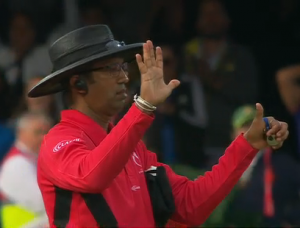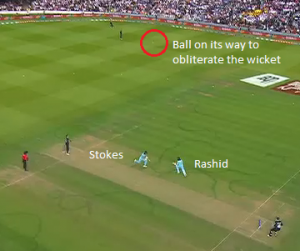Overthrow or wilful act of fielder - Laws of Cricket
|
Cricket Anatomy™
Law 18.12.2 (Batsman returning to wicket he/she has left) shall apply as from the instant of the throw or act.
view template
|
Yesterday’s enrapturing Cricket World Cup final threw up a key decision, when, three balls from the end of the match, Martin Guptill’s throw from deep-midwicket, which was going to be a direct hit and run Ben Stokes out[1], cannoned off the back of Stokes’ flailing bat as he dived desperately to get anywhere near the crease before it did, and ran down and over the boundary for overthrows.
With haste which might transpire to be unseemly, Umpire Dharmasena held up six fingers: Four runs for the overthrow and two for the runs the outfield batsmen completed. But a quick look at Law 19.8 tells a different story: where the boundary results from “an overthrow or from the wilful act of a fielder”, the runs scored shall be (a) any applicable penalties (wides or no-balls: here, none); (b) the allowance for the boundary (four); (c) completed runs (one)
together with the run in progress if they had already crossed at the instant of the throw or act.
The wilful act in question — also as it happens, a throw — is Martin Guptill’s from deep midwicket. The ball’s deflection by Ben Stokes’ bat from what was obviously its true path to obliterate the wicket is certainly not a “throw”, much less a “wilful act of a fielder” — it has no cricketing significance at all, in fact — so the question is where were the batsmen at the time Guptill let the ball go.
And at that point, they had not crossed, as this picture demonstrates. Now there is a kicker, because, having only scored one run, Stokes and Rashid should have been sent back to where they started that run, with Stokes at the non-striker’s end:
- 18.12.2 If, while a run is in progress, the ball becomes dead for any reason other than the dismissal of a batsman, the batsmen shall return to the wickets they had left, but only if they had not already crossed in running when the ball became dead. ...
So Adil Rashid should have been required to face the final two balls, and obliged to score four runs to win.
And here is where the path dependency of Cricket comes in to illustrate why we can’t undo history: We know (with a fair amount of confidence) that Stokes would only score three off those final two balls, because that is what he did do. But we don’t know what Adil Rashid would have done: while he might be a tail-end batsman who has just arrived at the crease, but he was denied the ability to show that he was going to smear the ball over cow corner for six match-winning runs.
And this is why cricket is such a good metaphor for life. There is caprice, cruel fate, uncertainty and error, but the overall experience is all the more magnificent for it. The record remains as it was written: well played England; worthy world champions.
See also
References
- ↑ Prove it wouldn’t have okay?

